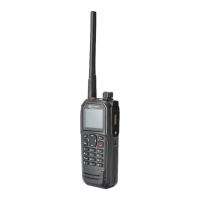DP770 Service Manual
The transmitter circuit includes three parts:
• Transmitter Power Amplifier
T
he carrier signal generated by the TX VCO is modulated and amplified, and feeds to the transmitter circuit
via the following steps.
Step1: The signal passes a Π-type attenuator, realizing segregative isolation between RF power amplifier
circuit and TX VCO.
Step2: The signal are pre-amplified by a pre-driver amplifier (UHF: Q301, VHF: Q72), providing further
segregative isolation between itself and the next level amplifier.
Step3: The signal goes to the next pre-amplifier and drive amplifier (RD01) to obtain further amplification,
guarantying to provide enough driver power signal to the final-stage amplifier (RD07) and obtain the final
power amplification..
Step4: After amplified by multiple amplifiers, the transmitter signal is processed by a microstrip line to
complete output impedance matching at the output of final-stage amplifier, to reduce the output loss caused
by impedance mismatch.
Step 5: The transmitter signal goes through the RX/TX switch and enters to the low-pass filter.
• Low-pass Filter Circuit of suppressing the harmonics
The low-pass filter is high-grade low-pass filter composed of lumped-parameter inductors and capacitors.
By this filter, the spurious signal within the stop band can be attenuated as much as possible while the
in-band ripple is within the required range.
• Auto Power Control Circuit (APC includes temperature detection circuit
)
I
n the auto power control and temperature detection circuit, the drain current from the driver amplifier and
final-stage amplifier is converted to voltage via the sampling resistor and subtraction circuit which is
composed of the first operational amplifier.
This voltage is compared with the APC control voltage of output by DAC at the second operational amplifier.
Then the error voltage controls TX power by controlling the bias voltage at the gate of amplifier (including
the driver amplifier and the final-stage amplifier. The temperature sensor IC detects the surface
temperature of the final-stage amplifier, and converts it to DC voltage. Then the DC voltage is compared
with the voltage corresponding to the protection temperature (generally 80% of the extreme temperature) of
the amplifier. If the temperature is too high, the bias voltage of the amplifier will be reduced until the surface
temperature falls below the protection temperature.
Page 7 of 102

